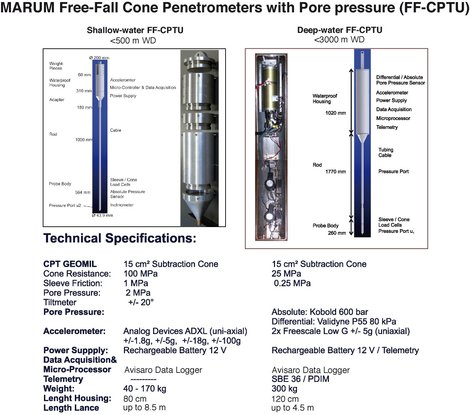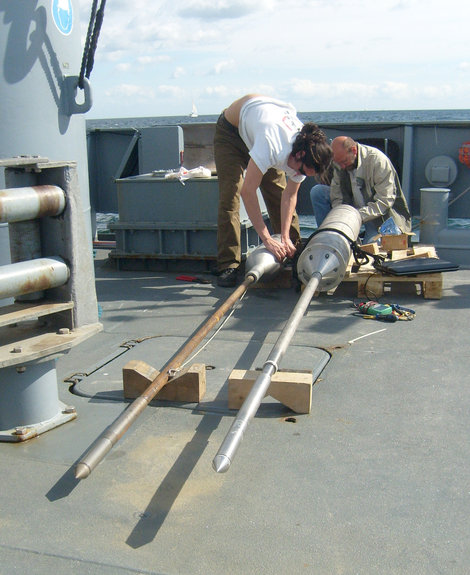Page path:
- Home
- Infrastructure
- Marine Technology
- Freefall CPTU Instruments
Freefall CPTU Instruments
SW-FFCPTU instruments
The MARUM-developed lance is an easy-to-use, lightweight free-fall CPT with pore pressure (FFCPTU) instrument for shallow marine application (200 m and 500 m water depth, respectively). The probe consists of an industrial 15 cm2 piezocone and a water-proof housing containing a microprocessor, volatile memory, battery, and accelerometers. Strain gauges inside the probe measure the cone resistance and sleeve friction by subtraction. A single pore pressure port (u2) is equipped with an absolute 2 MPa pressure sensor. An inclinometer is used installed to monitor the penetration angle at +/-30° relative to vertical, while temperature is monitored via a thermistor. Four accelerometers (1.7g, 5g, 18g, 100g) provides information about the descent velocities and deceleration behavior of the instrument upon penetration. Their data enable the user to calculate penetration depth during multiple deployments by integration. The aluminium pressure housing tolerates 2 MPa / 5 MPa confining pressure (ca. 200 m and 500 m water depth) and hosts the power supply and microprocessor. Frequency of data acquisition is variable, and is has usually been set to 1 kHz during our tests. Binary data are temporarily stored on a Micro Flash Card and then downloaded to a PC. Wireless data transfer (via WLAN) is also implemented. The two non-volatile battery packs available provide performance times of about six and twelve hours, respectively.
Our instrument is designed for both pogo-style measurements from moving platforms as well as mid-term deployments from a crane, winch, anchored vessel, or tied to a buoy. The length of the lance varies from 1.5 m (short mode) up to a max. 8.5 m (long mode). The extension is accomplished by adding 1m-long metal rods and internal extension data/power cables within them. The weight of the instrument thus ranges from ca. 45 kg (1.5 m) to max. 140 kg (8.5 m). If deep penetration is desired, modular weight pieces (15 kg each) can be mounted to the pressure housing at the top of the instrument, then reaching a max. 200 kg. This construction allows us variable testing methods depending on the platform, geological setting and the scientific question. The light-weight version can be handled almost effortlessly by an individual. Even at a length of 6-8 m, the instrument can be deployed from relatively small boats by two people, recovery is facilitated by a portable 4x4 car winch powered by a battery. However, the easiest way to operate the device is by a regular winch and deep-sea cable on research vessels, either over the side or the A-frame.
The autonomous instrument has been used for long-term dissipation overnight. Here, the lance can be left deployed over the desired period, e.g. connected to a buoy or other mooring. If on a positioned platform, step-like measurements can be carried out at certain depth intervals, with pore pressure dissipation monitored for 10s of minutes to hours at many levels of the depth profile. Until now, the FF-CPTU has been deployed from bridges, small pontoons and boats at lacustrine (Lakes Lucerne and Neuchatel, Switzerland; several lakes in New Zealand) and estuarine sites (Weser estuary, NW Germany), and from larger vessels in the North and Baltic Seas (e.g., RV Planet), the Mediterranean Sea (e.g. RV Poseidon, RV Meteor), and off New Zealand.
Our instrument is designed for both pogo-style measurements from moving platforms as well as mid-term deployments from a crane, winch, anchored vessel, or tied to a buoy. The length of the lance varies from 1.5 m (short mode) up to a max. 8.5 m (long mode). The extension is accomplished by adding 1m-long metal rods and internal extension data/power cables within them. The weight of the instrument thus ranges from ca. 45 kg (1.5 m) to max. 140 kg (8.5 m). If deep penetration is desired, modular weight pieces (15 kg each) can be mounted to the pressure housing at the top of the instrument, then reaching a max. 200 kg. This construction allows us variable testing methods depending on the platform, geological setting and the scientific question. The light-weight version can be handled almost effortlessly by an individual. Even at a length of 6-8 m, the instrument can be deployed from relatively small boats by two people, recovery is facilitated by a portable 4x4 car winch powered by a battery. However, the easiest way to operate the device is by a regular winch and deep-sea cable on research vessels, either over the side or the A-frame.
The autonomous instrument has been used for long-term dissipation overnight. Here, the lance can be left deployed over the desired period, e.g. connected to a buoy or other mooring. If on a positioned platform, step-like measurements can be carried out at certain depth intervals, with pore pressure dissipation monitored for 10s of minutes to hours at many levels of the depth profile. Until now, the FF-CPTU has been deployed from bridges, small pontoons and boats at lacustrine (Lakes Lucerne and Neuchatel, Switzerland; several lakes in New Zealand) and estuarine sites (Weser estuary, NW Germany), and from larger vessels in the North and Baltic Seas (e.g., RV Planet), the Mediterranean Sea (e.g. RV Poseidon, RV Meteor), and off New Zealand.

DW-FFCPT
The 380-580 cm long deep-water (DW) free-fall CPT instrument is equipped with a standard 15 cm2 CPT piezocone with strain gauges inside the probe to measure cone resistance qc (25 MPa range) and sleeve friction fs (0.25 MPa range). In addition to the commercial cones (Geomil) we use a self-developed probe without friction sleeve that offers a more precise and reliable measurement of the remaining parameters. The instrument has two pore pressure ports, which are located at the cone (u1) and 80 cm above the cone (u3, following the CPT nomenclature); both ports are connected to high-resolution (10 Pa) differential pressure transducers (Validyne DP215, ±120 kPa range) via stainless steel tubing to a sea bottom water reference port. An absolute pore pressure sensor measures hydrostatic pressure (i.e. water depth) down to 3 km water depth. To prevent the entrapment of gas inside the tubing, especially during the initial phase of deployment when the instrument is lowered through the water column, valves are used to bleed the gas from the tubing. The pressure sensors are protected by valves in case high excess pore pressures are encountered. Temperature sensors and 2 bi-axial acceleration sensors are also connected to the Avisaro microcontroller (1 kHz operating frequency).
The DW-CPTU may either be run self-contained on batteries and equipped with a flash card, or could be run with a Seabird Electronics (SBE36) telemetric system, which powers the microcontroller, sensors, and valves. The telemetry provides real-time data acquisition as well as control of the instrument via an attached PC with custom-programmed LabView control software. The autonomous mode is utilised for long-term observation of the dissipation behaviour of pore pressure by disconnecting the deployed lance from the winch and recovering it after several hours. The raw data protocol was implemented for time, acceleration, absolute pore pressure (hydrostatic pressure), cone resistance, sleeve friction and differential pore pressures (u1, u3). Using the vertical component of acceleration, penetration velocity (1st integration) and depth (2nd integration) can be derived.
The DW-FFCPT has been successfully deployed in estuaries (river Weser, NW Germany) and in the ocean (Baltic Sea, Mediterranean Sea, Chile margin/SE Pacific, Nankai Trough/Japan) using various platforms.
The DW-CPTU may either be run self-contained on batteries and equipped with a flash card, or could be run with a Seabird Electronics (SBE36) telemetric system, which powers the microcontroller, sensors, and valves. The telemetry provides real-time data acquisition as well as control of the instrument via an attached PC with custom-programmed LabView control software. The autonomous mode is utilised for long-term observation of the dissipation behaviour of pore pressure by disconnecting the deployed lance from the winch and recovering it after several hours. The raw data protocol was implemented for time, acceleration, absolute pore pressure (hydrostatic pressure), cone resistance, sleeve friction and differential pore pressures (u1, u3). Using the vertical component of acceleration, penetration velocity (1st integration) and depth (2nd integration) can be derived.
The DW-FFCPT has been successfully deployed in estuaries (river Weser, NW Germany) and in the ocean (Baltic Sea, Mediterranean Sea, Chile margin/SE Pacific, Nankai Trough/Japan) using various platforms.
Contact
|
Phone: |
|
|
Fax: |
+49 421 218-65805 |
|
Email: |
|
|
Room: |
MARUM I / 2200 |



